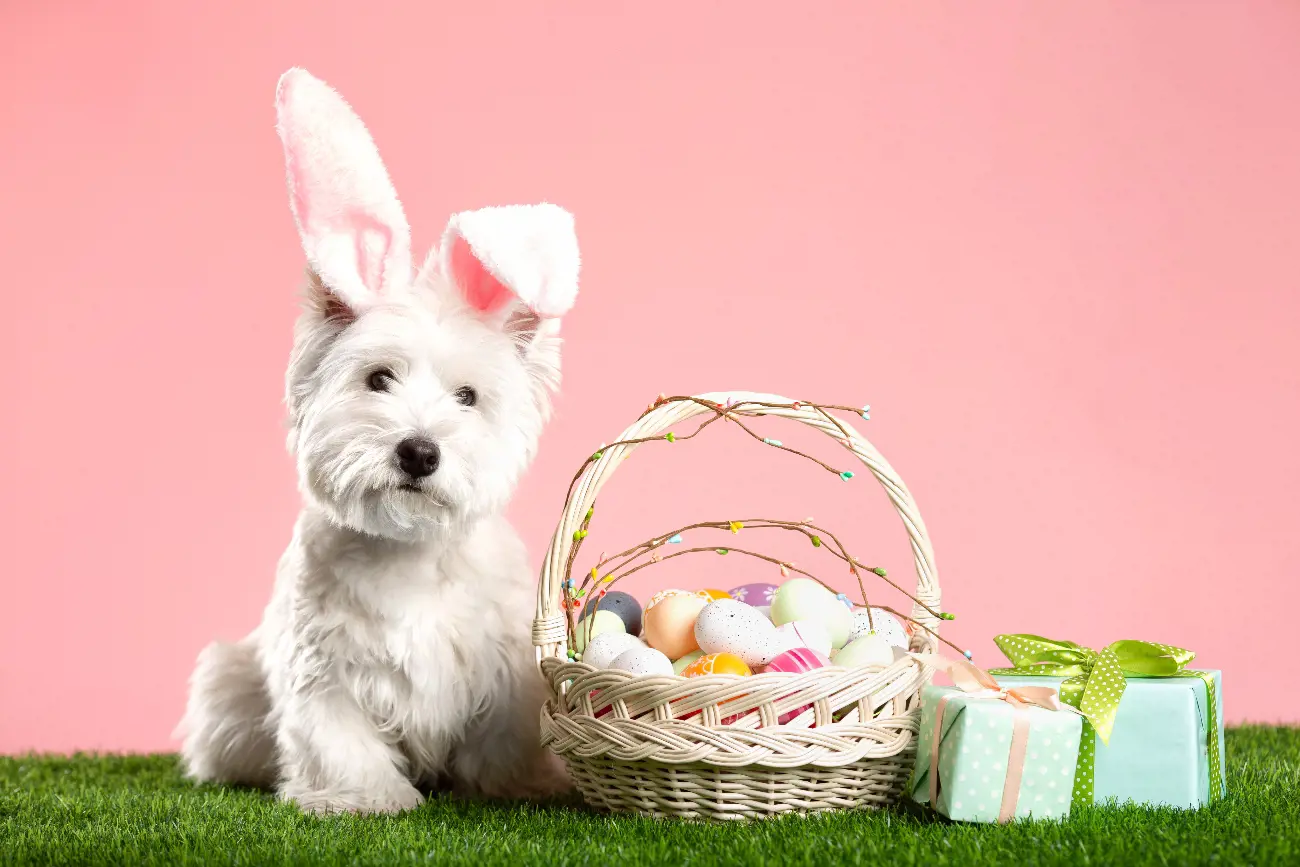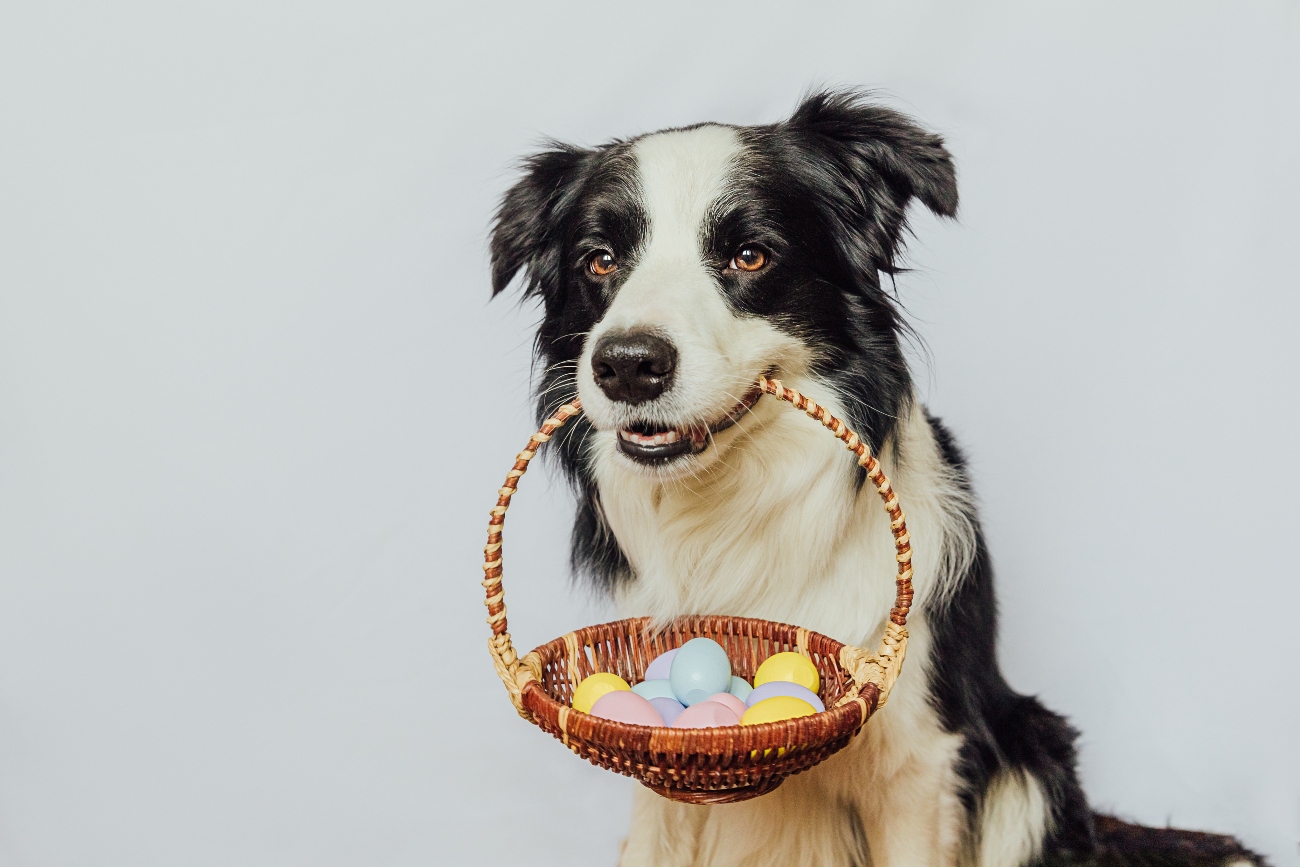Easter hazards for pets
29th February, 2024

For many dog owners, there’s nothing better than enjoying the bright days and light nights with their dogs over the Easter period. Unfortunately, however, there are a number of hazards which can pose a serious risk to our canine companions during this time.
It's not uncommon for our furry friends to chomp on something they shouldn't. And with the long Easter weekend fast approaching, it’s worth being extra vigilant – especially if you’re one to celebrate by stocking up on chocolate treats. Read on to find out how to keep your pet safe over this holiday.
Foods that may cause problems this Easter
Chocolate
Chocolate Easter eggs should be kept well out of your dog’s reach. Chocolate contains a chemical called theobromine – a bit like caffeine – that’s poisonous to dogs. The amount of theobromine depends on the type of chocolate, with dark chocolate being the most toxic.
Theobromine mainly affects the guts, heart, central nervous system, and kidneys and signs of theobromine poisoning will occur between four and 24 hours after your dog has eaten chocolate. Signs include vomiting, diarrhoea, restlessness, hyperactivity, and seizures. Chocolate may also contain other ingredients that are toxic to dogs such as raisins and certain types of nuts, like macadamia nuts.
Hot cross buns
Hot cross buns which contain dried fruit, such as currants, sultanas, and raisins, are all toxic to dogs. Even if your dog devours just a few raisins or small quantity of these dried fruits (and grapes), they can suffer severe kidney failure which may be fatal.
Macadamia nuts
Macadamia nuts are toxic to dogs. Your pup would only need to eat a small amount of food containing these nuts to experience negative results. Dogs who eat macadamia nuts most commonly experience weakness in the back legs, vomiting and diarrhoea.
If your pet eats macadamia nuts, you should contact your local veterinarian right away. Your dog will need care at a veterinary hospital if they start shaking constantly, have a high fever or becomes unable to walk.
Because macadamia nuts are a very fatty food, dogs in rare cases may experience an inflammation of the pancreas (pancreatitis) after eating them.
If you see your dog vomiting, experiencing lack of appetite, stomach pain or a decrease in activity level within three days of eating macadamia nuts, you should contact your vet right away.
Xylitol
If you’re baking a cake for Easter beware of xylitol. It’s an artificial sweetener used in home baking and found in many products including some sugar-free gums and diet foods. It can also be found in some Easter eggs. Dogs are extremely sensitive to xylitol and even tiny amounts can cause toxicity. Early symptoms of xylitol poisoning include lethargy, vomiting and loss of coordination. Seizures and even death may occur.
Flowers that appear in Easter
- Lilies
- Rhododendrons
- Daffodil
- Amaryllis
- Tulips
Did you know the UK produces 90% of the world’s daffodils? They can be found in the wild, in gardens and even bouquets. Along with Tulips, Hyacinths & Crocus both cats and dogs can be poisoned by eating these spring plants. All parts can be toxic, including the leaves however bulbs are often the most toxic part of the plant.
Spring bulbs
Easter is the perfect time of year to give a gift of spring flowers and bulbs, but make sure you keep them well out of reach of your dog – particularly if they like to chew or dig in the garden.
Daffodils
Daffodils, and other narcissus, are poisonous to dogs if they eat the bulbs or flowers, or drink water from a vase with daffodils in.
They can give your dog an upset stomach, make them vomit, and make them very sleepy and wobbly. A dog that’s been poisoned by daffodils might also have fits.
Fertilisers and herbicides
As gardening and yard work efforts increase, so do the inadvertent exposures of our pets to the various tools of the trade that help to ensure vibrant roses, blossoming buds, trailing ivy, and the greenest of grasses. Examples of these are weed killer and mildew control.
Toxicity among herbicides varies enormously, but pet poisoning can occur from as little contact as brushing up against a treated plant. The results can vary from vomiting to liver failure – so keep these chemicals well away from your pets at all times.
Other hazards to watch out for
Easter decorations (easy to swallow items)
Easter decorations can be hazardous for pets – for example, the fake grass and little fluffy chicks that come in Easter baskets. If your pet swallows these, they can get stuck at the back of their throats, or in their stomachs, and will not be able to pass through the intestines. Keep Easter decorations and small toys well out of your pet’s reach.
Insect bites/fleas
While new life is all around us during Spring, sadly this bloom also extends to some of our more unwelcome species. Fleas, ticks, and worms all start to grow in number around Easter as the weather warms up. This increases the chances of your pet encountering them.
Wasp and bee stings
Our pets can have a range of reactions to bee and wasps’ stings. At their least dangerous, stings are merely a painful inconvenience. At their worst, extreme immune reactions can cause serious swellings – if this is around the head and neck, constriction of the airways and restriction of breathing can be a major concern. If you see bees and wasps inside the home, safely remove them from any areas your pets may have access to.
Foil
It’s not uncommon for dogs to swallow things they shouldn’t, and plastic toys like those found in some Easter eggs and silver foil used to wrap eggs can pose a risk if ingested. Some objects may get lodged in the intestine or, worse still, the oesophagus.
What happens if a dog eats an Easter egg?

Easter eggs made of chocolate will contain a chemical called ‘theobromine’ which is toxic to dogs. Even small amounts of chocolate can cause
- vomiting
- diarrhoea
- hyperactivity
- tremors
- seizures (or fits)
- heart problems
- death, in severe cases
The darker the chocolate, the more potent the level of theobromine, and the more poisonous it is- but giving any type of chocolate to dogs must be avoided.
Even white chocolate, although it doesn't contain enough theobromine, is fatty and can pose a potential risk of upset tummies and even pancreatitis.
Call your vet if you suspect or know that your dog has eaten chocolate.
What Easter food can dogs eat?
Vegetables
Depending on what you’re actually cooking on your Easter roast, there should be quite a few vegetables that your dog can enjoy too. Some dogs will be keen to eat (or not notice) veg if it is covered in gravy, while others might be a bit more take it or leave it, but several Easter vegetables are safe for dogs. Carrots are fine for dogs, although it is best not to give a dog carrot that are cut into rounds, as these might be just the right shape and size to lodge in your dog’s windpipe, which can potentially cause choking.
Dogs can also eat celery, green beans, and peas. They can eat corn off the cob too, and also squash, sweet potato, potato, cauliflower, and broccoli.
Roast Lamb
Roast lamb is perhaps the most common and popular meat we eat for our Easter roast dinners, and lamb in and of itself is not toxic to or dangerous to dogs. It can, however, be dangerous depending on how you prepare it (once more, garlic, and plants from that family are toxic to dogs).
You should also never give your dog cooked lamb bones; while a shank or long leg bone is fine and a nice treat for a dog when raw, cooked bones are dangerous for dogs and can splinter and cause them an injury. Bear in mind that lamb is a very fatty meat, and so you should trim lean pieces for your dog and only feed them a small amount of lamb!
Gravy
If you make a gravy mixture that is low salt and vitally, not made with garlic or onion (or made from juices from meats and veg that include garlic or onion) then your dog can have this. Most of us make seasoned gravy though or add juice from the meat; so, you might want to make up a special plain gravy for your dog instead, once more, taking care to use one that does not include onion.
There's plenty of other things your pets can do that don't involve eating. Is there a trick you'd like to teach your dog? You could show it off to your friends and family if they are coming round to celebrate. Or you could make the most of the spring sunshine and take your dog for some long walks.
Common signs of poisoning in dogs
Many dogs will get into anything they come across, and of course, that puts the dog’s health at risk. Teaching a “leave it” cue to your dog can be a lifesaver, but you can’t watch your pet every minute of the day.
It’s important to know the common signs of poisoning and how to respond in case your dog encounters something dangerous.
The following may be signs of dog poisoning:
- Bruising or bleeding (best found in areas of little or no hair, such as the gums, inside the ear flaps, and inside the groins, nose bleeds or bloody urine
- vomiting or blood in the stool (either bright red blood or dark black tarry stools)
- diarrhoea
- hyperactivity or restlessness
- tremors
- seizures (or fits)
Poisoning can cause a whole range of effects within your dog’s body. Some are immediate and others can have longer-term consequences like anaemia or organ damage. Plus, some signs will be impossible to notice on your own like cardiac problems, such as an irregular heartbeat, or liver failure. That’s why it’s so important to take any noticeable symptoms seriously and consult your veterinarian immediately.
How do you keep pets safe at Easter?
It can be hard to ensure that your dog doesn’t get the opportunity to steal some cake, chocolate eggs or other food at Easter, if you have kids, who will likely be very excited themselves and having a great time-which is why it is extra important to keep an eye on what your dog is up to, where they are-and if they have gone uncharacteristically quiet, why this might be!
If your dog likes to be involved in family activities, why not plan a treat hunt for them? Just like an egg hunt, hide some of your dog’s favourite treats or food around your garden or house and let them sniff them out.
To avoid over feeding your dog certain seasonal treats, take roughly some of their daily food and use that as their treat allowance for the day, or reduce their daily food by 10% to account for other healthy treats.
Helpful Pages
Recent Posts
Pet Insurance Quote
- 98% claims paid *
- Claims paid directly to vets
- 24/7 vet video consultations
- Interest free monthly payments




